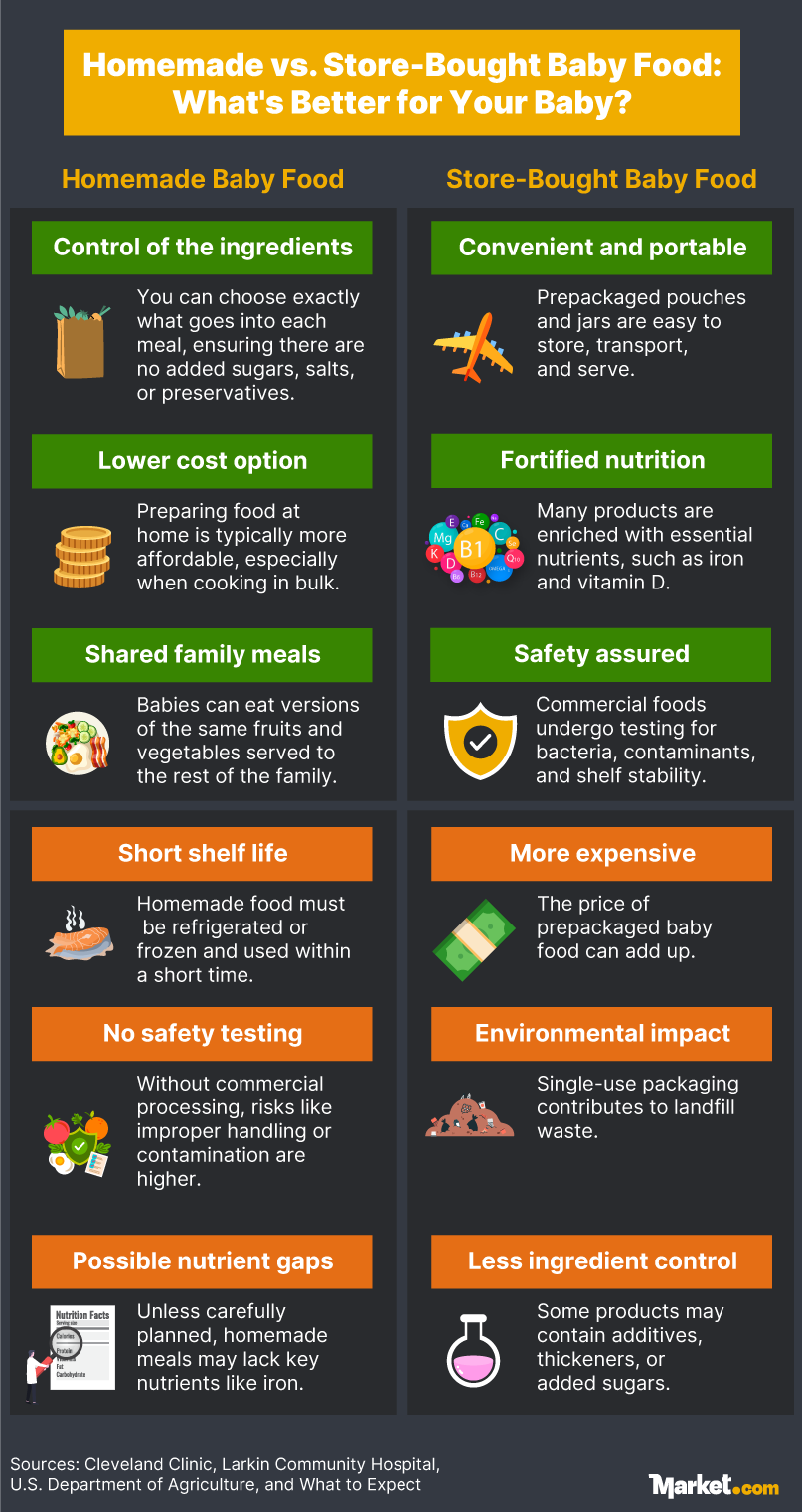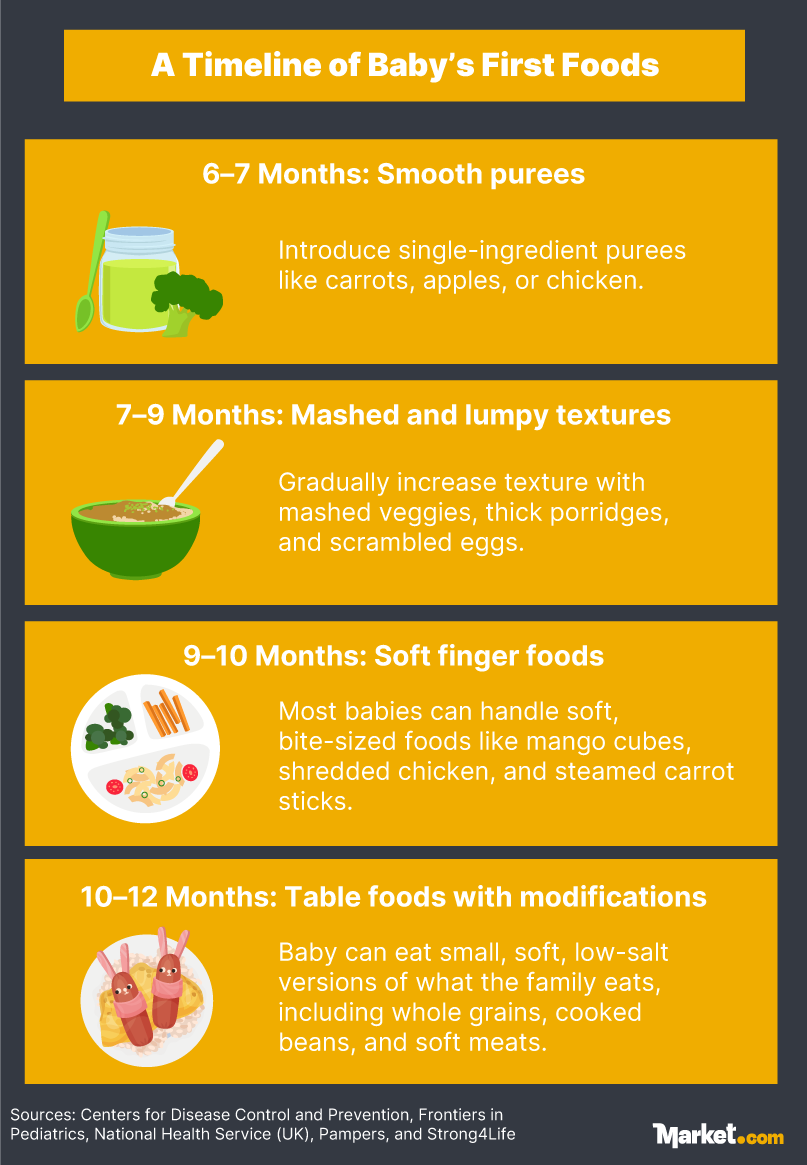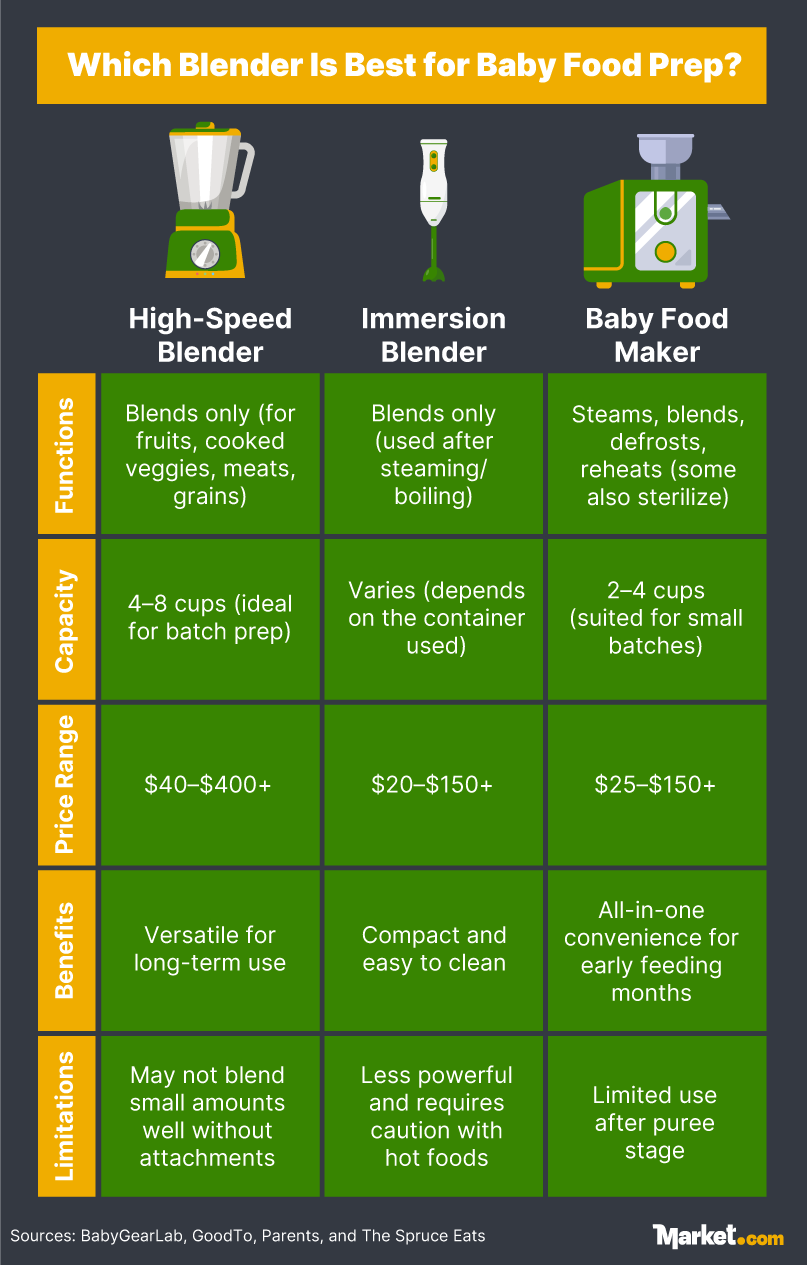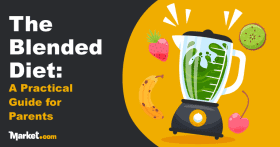![[Draft] A Guide to Blending Foods for Parents with Babies](https://www.market.com/wp-content/uploads/2025/10/-draft-a-guide-to-blending-foods-for-parents-with-babies-1.png)
The Blended Diet: A Practical Guide for Parents
In many households with young children, blended meals and baby smoothies are a staple, and for good reason. They’re quick to prepare, easy to eat, and far less messy than a handful of blueberries or a bowl of spaghetti! Whether it’s a pouch on the go or a homemade veggie purée, blended foods can make starting solids more manageable for parents and babies.
Blenders are incredibly useful tools in these early stages of development. They let you control ingredients, introduce new flavors, and meal prep larger batches of food. But not all blending is equal. Relying on smooth foods for too long can delay important developmental skills for babies, including chewing, speech, and oral motor control.
This guide covers what you need to know about blended vs. solid foods. We’ll look at when purées are most helpful, when to move on, and how to support your baby’s feeding development without overusing the blender.
What Is the ‘Smoothie Trap’?
Purées and smoothies are a common starting point when introducing young children to solids. They’re safe, familiar, and convenient, especially during the early months of eating solids, offering an easy way to introduce new flavors and nutrients. Used appropriately, blended foods can support feeding development and nutrition in the first stages of eating.
But before we get into all the benefits, it’s important to address one common pitfall. Many parents fall into what’s known as the “Smoothie Trap,” relying on blended meals well past the stage when babies should be introduced to textured foods. It’s an easy habit to form, especially when food pouches are everywhere and your baby can slurp them down on the go.
The problem is that babies need to chew, even if they don’t yet have teeth. By around 6 to 9 months, most babies are ready for soft, lumpy textures that encourage them to move food around their mouths. Chewing strengthens the jaw, helps align growing teeth, and builds the oral muscles needed for speech.
Chewing also plays a critical role in digestion by activating saliva, triggering gut hormones, and improving nutrient absorption. A scientific journal from 2024 found that chewing significantly shapes the gut microbiome, boosting microbial diversity and digestive health.
When babies eat real food, like soft vegetables or small chunks, they’re also naturally cleaning their teeth and stimulating gum health. Prolonged reliance on purées has been linked to delayed speech, underdeveloped jaws, and higher risks of misaligned teeth. Delaying solids can also increase the risk of picky eating, especially when children become used to smooth, sweet foods.
A 2019 study found that baby pouch foods contained significantly more sugar per serving than similar foods from other sources, and that prolonged exposure can increase mouth acidity, erode teeth, and lead to cavities. These pouches are sometimes marketed as “veggie blends” when the main ingredient is actually fruit. While purées have their place, they shouldn’t be the meal of choice beyond 10 months.
Comparing the Nutritional Value of Whole and Blended Foods
A common concern among parents is whether blending fruits and vegetables reduces their nutritional value, especially their fiber. This idea, the “fiber myth,” suggests that purées lose fiber or that fiber becomes ineffective once blended. But research shows that blending doesn’t destroy fiber. It simply reduces particle size, much like chewing. The fiber stays intact and continues to support digestion, regulate blood sugar, and feed beneficial gut bacteria.
In fact, blending may make some nutrients more available. Breaking down plant cell walls can release antioxidants and vitamins that are harder to access when eating whole foods. One study found that blending apples and berries led to lower blood sugar spikes compared to eating them whole because the crushed seeds released more fiber and slowed sugar absorption.
Blending foods retains vitamins, minerals, and antioxidants, especially when served soon after preparation; nutrient loss from oxidation is minimal in the first 15–20 minutes. Unlike juicing, which removes pulp and fiber, blending keeps all of the edible parts. Here are a few common baby- (and blender-) friendly foods that offer high nutritional value:
- Carrots: Packed with beta-carotene and vitamin A to support healthy vision and immune function.
- Sweet potatoes: Rich in fiber and antioxidants that aid digestion and regulate blood sugar.
- Spinach: Full of vitamin K and iron, important for bone growth and oxygen circulation.
- Green peas: Provide plant-based protein, fiber, and folate to support brain and gut development.
- Blueberries: High in vitamin C and antioxidants that help build the growing immune system.
- Lentils: A great source of iron and protein to support growth and prevent anemia.
Many parents also wonder whether it’s better to prepare food at home or rely on store-bought options. A 2023 study in the U.S. found that 60% of commercial baby foods failed to meet nutritional standards due to added sugars, and a 2021 congressional report flagged concerning levels of heavy metals in many products. While homemade meals offer more control over ingredients and texture, both options have pros and cons.

For most families, a mix of store-bought and homemade foods, paired with informed choices, can offer the best balance of nutrition, safety, and practicality.
What Foods Can You Blend?
Blending is a practical way to prepare baby food, especially in the early months when babies haven’t yet developed the coordination to chew. But not every food is safe to blend raw. Some need to be cooked to ensure they’re soft enough to digest and won’t pose a choking risk.
Some of the best options for first purées include:
- Soft fruits, such as bananas, avocados, ripe pears, peaches, and mangoes: Can be blended raw and are rich in healthy fats, fiber, and vitamins. Firm fruits should be peeled and steamed, or baked until soft, before blending.
- Cooked vegetables, including carrots, yams, beets, peas, green beans, broccoli, cauliflower, spinach, and kale: Must be fully cooked to soften texture and aid digestion.
- Boiled grains and cereals, such as oats, quinoa, brown rice, barley, and iron-fortified baby cereals: Blend with water, breast milk, or formula to reach a baby-safe consistency.
- Plant-based proteins, like well-cooked lentils, split peas, and beans: Provide iron and protein for healthy growth.
- Fully cooked meats, such as chicken, beef, and turkey: Should be blended with a small amount of water or broth to make them easier to swallow.
Foods that you should avoid when blending your own baby food:
- Raw hard fruits and vegetables, such as apples or carrots: Hard to digest and pose a choking risk unless fully cooked.
- Processed meats, like ham, bacon, or deli meat: High in salt, nitrates, and additives, not suitable for infants.
- Sticky or thick foods, like nut butters: Difficult to blend safely and can block airways.
- Honey: Unsafe for babies under 12 months due to the risk of botulism.
- Unpasteurized or soft cheeses, such as brie or blue cheese: May contain harmful bacteria and aren’t suitable for blending.
- High-mercury fish, such as tuna, swordfish, or marlin: Should be avoided due to toxicity risks.
- Cow’s milk: Not suitable, even as a blending base, as it lacks the right nutrients and may strain a baby’s kidneys. Use breast milk, formula, or water instead.
- Rice drinks or rice milk: Can contain unsafe levels of arsenic for babies.
Globally, blended foods look a little different, as babies often eat blended or mashed versions of their family’s staple foods. Some common dishes from around the world include:
- Koko (Ghana): A fermented maize porridge that’s smooth, easy to digest, and rich in probiotics.
- Congee (China): A mild rice porridge often served with mashed pumpkin, tofu, or white fish.
- Kheer and khichdi (India): Sweet rice pudding made with milk (kheer), and a savory mix of rice, lentils, and vegetables cooked with mild spices (khichdi).
- Hummus and baba ghanoush (Israel): Blended chickpeas with tahini (hummus) and roasted eggplant purée (baba ghanoush).
Regardless of the region, the idea stays the same: finding nutrient-dense foods tailored to your baby’s age and abilities, often made with ingredients you already have at home.
When to Blend and When to Offer Whole Foods
Blended foods are a great starting point when introducing solids to your baby, which is typically at around 6 months.
According to the American Academy of Pediatrics, babies are generally ready for solids when they can sit upright with good head control, show interest in food (like reaching for it or opening their mouth when food is offered), and move food into the back of their throat without spitting it out.
Gradual texture transitions help develop chewing, oral strength, and self-feeding skills, so knowing when and how to progress to textured foods is important.

6–7 Months: Smooth Purées
This is the stage where most babies begin their solid-food journey. The World Health Organization (WHO) recommends introducing nutrient-dense purées alongside breast milk or formula at six months.
There’s no single “best” first purée to give a baby. The American Academy of Pediatrics suggests offering a variety of foods in these early months, like meats, cereals, vegetables, fruits, eggs, and fish, while continuing with breast milk or formula. These can be homemade or store-bought, as long as they are age-appropriate and free of added salt or sugar.
To safely monitor for food allergies, the Center for Disease Control (CDC) recommends offering only one new single-ingredient food at a time and waiting three to five days before adding another. Start with a small amount, increasing gradually if no reaction occurs.
Common allergens (like peanut, egg, dairy, wheat, or soy) should be introduced in baby-safe forms and only after your baby is tolerating other foods well.
7–9 Months: Mashed and Lumpy Textures
As babies become more confident eaters, texture should be gradually increased. During this window, mashed fruits and vegetables, thick porridges, soft scrambled eggs, and well-cooked grains like oatmeal help develop oral-motor skills.
This is also a good time to introduce safe finger foods like soft tofu, steamed vegetables, and banana slices. At this stage, many babies enjoy holding their own spoon, even if they haven’t quite figured out how to use it. Letting them experiment with self-feeding helps build coordination and independence.
9–10 Months: Soft Finger Foods
By this age, most babies can sit unassisted and bring food to their mouths confidently. You may begin to notice some signs that your baby is ready to move beyond purées and explore more challenging textures. For example:
- They chew or gum food rather than just swallowing
- They handle small lumps without gagging
- They show interest in self-feeding or using a spoon
- They’re eager to try what’s on your plate
Offer small, soft finger foods that dissolve easily or can be gummed, like mango cubes, steamed carrot sticks, and shredded chicken. This stage is less about perfection and more about practice. Babies refine their hand-eye coordination and learn how to manage different textures in their mouths.
10–12 Months: Table Foods with Modifications
By the end of the first year, most babies are ready to join in on family meals, with a few modifications. Offer chopped or shredded versions of what the rest of the family is eating, ensuring everything is soft, easy to chew, and low in added salt or sugar.
Studies show this is also a good time to increase dietary variety by adding soft meats, whole grains, and cooked beans to meals. Encourage self-feeding with a spoon or fingers to further support fine motor development and mealtime independence.
Choosing the Right Blender for Baby Food
Preparing baby food at home doesn’t require a fancy blender, but the blender you choose does need to work well for the kinds of meals you’ll be making. The right blender can make the process faster, safer, and more effective.
Here are some of the features parents should look for in a baby food blender:
- Ease of use: Choose a model with simple controls and minimal setup. One-touch or two-step operation reduces hassle, and built-in timers or texture presets can be helpful.
- Texture control: Multiple speeds or a pulse function allow you to adjust consistency as your baby transitions from smooth purées to thicker textures.
- Easy cleaning: Dishwasher-safe parts and wide containers with few crevices make cleaning easier. For steam units, ensure the water tank is easy to access and rinse.
- Size and capacity: A 2–3 cup blender suits small batches, while a 4–6 cup is better for bulk prep. Make sure it fits your storage or counter space.
- Noise level: Quieter models can be useful for prepping food during naps or nighttime.
- Safety and materials: Look for BPA-free or glass containers, locking lids, auto shut-off, and safeguards that prevent use when parts aren’t properly assembled.
- Durability: Stainless steel blades, strong motors, and sturdy containers last longer. Glass bowls and metal parts usually hold up better than plastic. Check customer reviews too, as these can sometimes reveal hidden issues like leaking parts or premature motor failure.
Once you know what features matter, the next step is choosing the type of blender that best fits your routine. Here’s how the main types compare:

1. High-Speed Blenders
These are traditional countertop blenders with strong motors and variable speed settings. They can blend soft and cooked ingredients into a very smooth texture, which is useful during the early purée stage. Most models support texture adjustments as feeding needs change. However, they do not steam food, so ingredients must be cooked separately before blending.
2. Immersion Blenders (Hand Blenders)
These handheld blenders allow you to purée food directly in the pot or bowl after cooking. They’re compact, lightweight, and easy to clean. Immersion blenders work best with soft, cooked foods and are a practical option for small batches. They are less effective for harder ingredients or tougher textures.
3. Baby Food Makers (All-in-One Units)
These appliances combine steaming and blending in one machine, often with additional functions like reheating, defrosting, or bottle warming. They are designed specifically for baby food preparation and tend to have smaller capacities. While not as powerful as high-speed blenders, they simplify the cooking process and reduce the handling of hot food.
Things Every Parent Should Know Before Making Baby Food at Home
Making baby food at home gives you more control over ingredients, freshness, and texture — but there are a few key things to keep in mind to make sure your approach stays balanced, safe, and developmentally appropriate.
- Store homemade food safely: Refrigerate purées within 2 hours of cooking and use them within 1–2 days. For longer storage, freeze in small portions (like ice cube trays), then transfer to labeled freezer bags. Most frozen purées last 1–2 months.
- Handle and reheat food properly: Reheat food until steaming, then cool to a safe temperature. Never refreeze thawed food. If your baby doesn’t finish a serving, discard the rest—saliva introduces bacteria that are invisible to the naked eye, but can spoil food.
- Check for spoilage every time: Throw food away if it smells sour, looks discolored, has mold, or separates into watery layers. When in doubt, toss it out. Babies are more sensitive to foodborne illness than adults.
- Time meals strategically: Try solids when your baby is a little hungry, but not overly tired or full, so about 30 to 90 minutes after a milk feed. Avoid offering purées as the fallback if they refuse new textures. This window between 6–9 months is critical for texture development.
- Watch for signs of over-reliance on pureées: If your baby consistently refuses lumpy foods, gags on texture, or waits for smoother backup meals, they may be too reliant on blended foods. Try mixing small whole foods (like minced meat) into purées or offering soft mashed foods alongside their usual meals.
- Include texture variety throughout the day: A balanced day might include smooth oatmeal in the morning, mashed veggies and soft meat at lunch, and steamed finger foods at dinner. Even if purées are still part of the meal, include at least one food that encourages chewing.
- Offer safe opportunities to chew: Choose foods that are soft enough to mash between your fingers, like steamed vegetables, ripe fruits, or baby puffs. Let your baby gnaw on safe options like a soft carrot stick or mango pit under supervision. Once they develop a pincer grasp, introduce small, soft finger foods.
Preparing baby food at home can be simple and rewarding with the right approach. Planning ahead, gradually introducing new textures, and storing food safely helps ensure your baby gets the nutrients they need while building important eating skills.
Conclusion
Blended foods can play an important role in the early stages of feeding, especially when made at home with safe textures and nutritious ingredients, but they should be used with intention. Supporting your baby’s development means knowing when to thicken textures, introduce chewable foods, and encourage self-feeding.
The key is balance. Blended meals can be helpful, but they shouldn’t replace opportunities to chew, explore, and engage with food. With the right tools and a bit of planning, you can build healthy habits from the start.
And remember, every baby is different. If you’re unsure about what’s best for your child, speak with a pediatrician or feeding specialist for guidance that’s right for your family.


